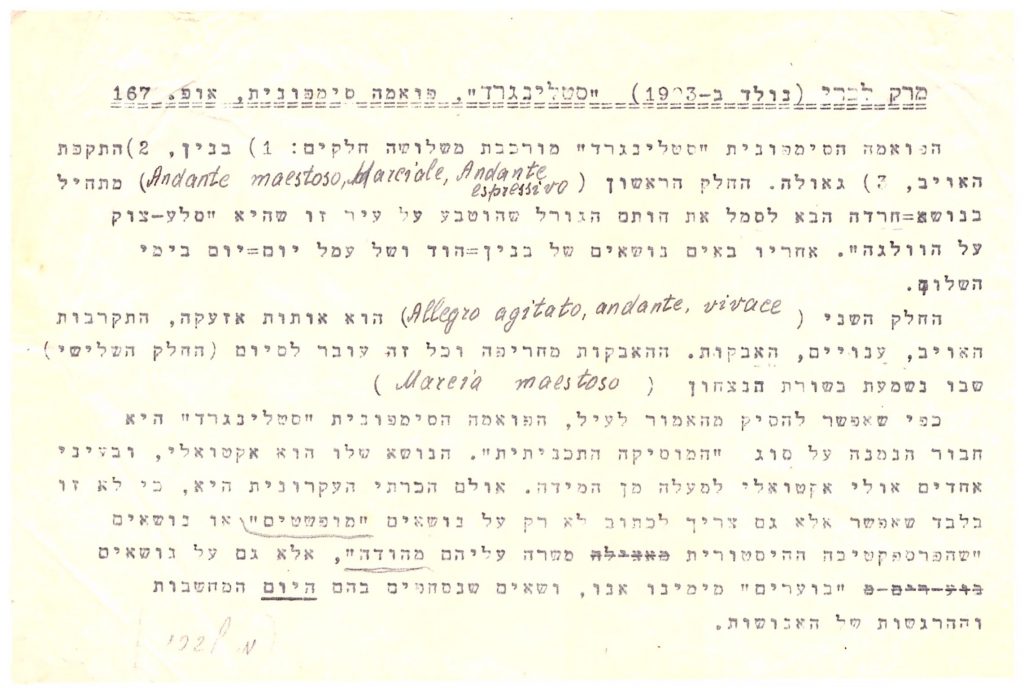
War and Peace, Symphonic Poem
The first performance of the composition since 1944 at a concert by the Israeli Philharmonic Orchestra on August 8, 2024 as part of the Year of Marc Lavry 2023-2024.
Lahav Shani, Conductor
The Israeli Philharmonic Orchestra
Synopsis:
Lavry was always involved in his surroundings and often “documented” his reactions to events through music. The same is true of this 1943 symphonic poem, which he composed as the news broke of the fierce fighting between the German army and the Russian forces in Stalingrad that ended with the Allied victory. Lavry regarded the battle of Stalingrad as an analog for war and peace. In the composition one can hear three events: construction, enemy attack, redemption.
Lavry, who was known as the national musical illustrator of Israel, wrote about this composition: “[It’s a] necessary to create music about issues with which the historical perspective resonates, topics that are of the utmost current importance, topics that sweep the thoughts and emotions of humanity.”
The composition premiered on November 6, 1943 at the United Nations Music Festival in Alexandria, Egypt. It was performed by the Israeli Philharmonic Orchestra conducted by Georg Singer. Prior to this performance Lavry was asked to write a few words about the piece.
For research purposes:
Reviewing Marc Lavry’s composition, it is clear that the composer documented the event as they unfolded, in music.
Understanding Lavry’s philosophy sheds light on his way of thinking and his source of inspiration for the subjects of his work.
In April 2021, Efrat Lavry, the composer’s daughter, found in a pile of letters a crumpled note, printed on a typewriter, with a description of the composition as Lavry dictated to an anonymous writer. The language does quite match that of the composer, and it is clear that he dictated his thoughts in Russian and the writer translated them into Hebrew. (The awkward and cumbersome Hebrew indicates the translator’s limited translation capabilities). Lavry signed the article.
Lavry analyzes the structure of the composition and explains his writing philosophy: its sources of inspiration and how he views his role as a composer.
Note: Lavry originally named the composition “Stalingrad” but the subject is greater and it was later renamed “War and Peace”.
The Symphonic Poem… consists of three parts:
- Construction (Binyan)
- Attack of the enemy (Hatkafat Oyev)
- Redemption (Ge’ula)
The first part (Andante Maestoso, Marciale, Andante Espressivo) begins with the anxiety over the destiny imposed on this city which is “a boulder on the Volga”. This is followed by the themes describing reconstruction, magnificence and daily work during peacetime.
The second part (Allegro Agitato, Andante, Vivace) describes the emergency sirens, the enemy’s approach, torture, and combat. The combat exacerbates and it all comes to an end (the third part) where the news of the victory is delivered (Marcia Maestoso).
As can be deduced from the above, the symphonic poem… is a composition that belongs to the genre of “programmatic music”. The subject is topical, and to some it may be too topical. But I believe that not only is it possible to write about topics beyond those “abstract” one, but necessary to create music about issues with which the historical perspective resonates, topics that are of the utmost current importance, topics that sweep the thoughts and emotions of humanity.
Marc Lavry
Recognition: Special thanks to Ari Rabenu for the engraving and proofing of the War and Peace sheet music.
Performances
Premier: United Nation Music Festival in Alexandria, Egypt
November 6, 1943
The Israeli Philharmonic Orchestra
George Singer, Conductor

A program from the first performance of Lavry’s War and Piece (originally known as Stalingrad) in Palestine in 1944 by the Israeli Philharmonic Orchestra
Performance in Tel Aviv, Israel
1944
The Israeli Philharmonic Orchestra
George Singer, Conductor





